Lead-ion potentiometric sensor based on electrically conducting microparticles of sulfonic phenylenediamine copolymer
Abstract
A potentiometric sensor to detect lead ions using newly synthesized conducting copolymer microparticles as an ionophore in self-supporting poly(vinyl chloride) membrane matrix plasticized with dioctyl phthalate was developed. The copolymer microparticles containing many ligating functional groups including amino, imino and sulfonic groups were synthesized by a chemical oxidative copolymerization of m-phenylenediamine (mPD) and p-sulfonic-m-phenylenediamine (SPD) in pure water. Due to the presence of –NH–, –N![[double bond, length as m-dash]](https://www.rsc.org/images/entities/char_e001.gif) , –NH2, and –SO3H ligating groups on the microparticles, a linear Nernstian response is obtained within a Pb(II) activity range from 1.00 × 10−6 M to 1.00 × 10−3 M. The Pb(II)-sensor containing the mPD/SPD (95/5) copolymer microparticles with the maximal electrical conductivity demonstrates a superior detection limit down to 1.26 × 10−7 M, short response time to 14 s, and long lifetime of up to 4 months. The Pb(II)-sensor also exhibits a selective response to Pb(II) over 9 other metal ions and a pH independent plateau between 2.7 and 5.0. These advantages could make for a robust sensor performing credible analysis of Pb(II) concentration in real-world samples at trace levels.
, –NH2, and –SO3H ligating groups on the microparticles, a linear Nernstian response is obtained within a Pb(II) activity range from 1.00 × 10−6 M to 1.00 × 10−3 M. The Pb(II)-sensor containing the mPD/SPD (95/5) copolymer microparticles with the maximal electrical conductivity demonstrates a superior detection limit down to 1.26 × 10−7 M, short response time to 14 s, and long lifetime of up to 4 months. The Pb(II)-sensor also exhibits a selective response to Pb(II) over 9 other metal ions and a pH independent plateau between 2.7 and 5.0. These advantages could make for a robust sensor performing credible analysis of Pb(II) concentration in real-world samples at trace levels.


 Please wait while we load your content...
Please wait while we load your content...